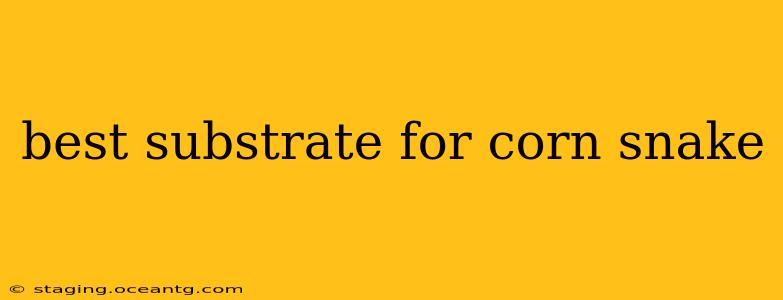Choosing the right substrate for your corn snake is crucial for their health and well-being. The substrate forms the base of their enclosure, affecting humidity levels, hygiene, and overall comfort. This guide will explore the best options, addressing common concerns and helping you make an informed decision.
What Makes a Good Corn Snake Substrate?
A good substrate should meet several key criteria:
- Retention of humidity: Corn snakes benefit from slightly humid environments, especially during shedding. The substrate should help maintain appropriate moisture levels without becoming overly soggy.
- Ease of cleaning: Regular cleaning is essential for preventing bacterial and parasitic infections. The substrate should be easy to spot-clean and replace when necessary.
- Safety: The substrate should be non-toxic and not pose a risk of ingestion or impaction if accidentally consumed by your snake. Avoid substrates that can splinter, mold easily, or release harmful particles.
- Appropriate texture: The substrate should provide a comfortable surface for your snake to move and burrow on, if desired. However, it shouldn’t be so loose that it impedes movement.
Popular Substrate Options for Corn Snakes
Several substrates are commonly used for corn snakes. Let's analyze their pros and cons:
Aspen Shavings
- Pros: Readily available, affordable, absorbent, and readily retain some moisture.
- Cons: Can be dusty, potentially irritating sensitive snakes. May not be ideal for maintaining high humidity levels.
Cypress Mulch
- Pros: Retains moisture well, is relatively dust-free, and provides a natural-looking environment.
- Cons: Can be more expensive than aspen shavings, and some varieties may contain oils that could irritate your snake. Always check for quality and choose a snake-safe variety.
Paper Towels
- Pros: Extremely easy to clean and replace, inexpensive, and completely safe. Ideal for quarantine or baby snakes.
- Cons: Don't offer any enrichment or aesthetic appeal, and won't retain moisture.
Reptile Carpet
- Pros: Easy to clean, durable, and prevents burrowing.
- Cons: Doesn't retain moisture, and can be difficult to clean thoroughly if soiled.
Coconut Fiber (Coco Coir)
- Pros: Retains moisture exceptionally well, is relatively dust-free, and provides a natural-looking substrate. Many corn snake owners consider this the top choice.
- Cons: Can become compacted over time, requiring more frequent replacement, and may need to be pre-soaked before use.
What About Sand or Gravel?
Avoid using sand or gravel. These substrates are prone to impaction if ingested by your snake, leading to potentially fatal complications.
H2: How Much Substrate Should I Use?
The amount of substrate needed depends on the size of your enclosure and your snake's preferences. Generally, a layer of 2-4 inches is sufficient. You may use a thinner layer for young corn snakes and a thicker layer for adults who enjoy burrowing.
H2: How Often Should I Change the Substrate?
Spot-clean your enclosure regularly (daily or every other day), removing feces and urates. Completely change the substrate every 2-4 months or more frequently if it becomes soiled or excessively damp.
H2: Can I Mix Different Substrates?
Yes, you can mix substrates to create a custom blend that addresses your specific needs. For instance, you could mix coco coir with cypress mulch to achieve optimal moisture retention and a natural look.
Conclusion
Choosing the best substrate for your corn snake is a matter of balancing several factors. Consider your snake's age, your budget, and your cleaning preferences. Coco coir is generally regarded as an excellent choice, combining moisture retention with safety and ease of use. However, remember regular cleaning is paramount, regardless of your substrate selection. Observe your snake's behavior to ensure it remains comfortable and healthy in its environment. If you notice any signs of discomfort, consider switching to a different substrate.
